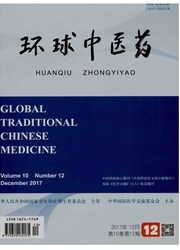

 中文摘要:
中文摘要:
通过观察结肠的 mucosal 为 ulcerative 大肠炎(UC ) 探索划分植物的艾灸的机制组织病理学说的变化和原子因素 kappaB (NF-B ) 和 peroxisome 的表示 UC 老鼠的激活 proliferators 的受体(PPAR ) mRNA。
 英文摘要:
英文摘要:
Objective: To explore the mechanism of herb-partitioned moxibustion for ulcerative colitis(UC) through observing the colonic mucosal histopathological changes and the expression of nuclear factor kappaB(NF-kB) and peroxisome proliferators-activated receptor γ(PPARγ) mRNA of UC rats. Methods: Male SD rats were randomly divided into a normal group and a model group. UC model was established by general immunological plus local irritation method. After model identification, rats in the model group were randomly divided into a model group, a herb-partitioned moxibustion(HPM) group and a Western medicine(Salicylazosulfapyridine, SASP) group. Rats in the HPM group received treatment at bilateral Tianshu(ST 25) and Dachangshu(BL 25), two cones for each point, once a day for 7 d. SASP group rats were gavaged with SASP. The pathological scores were evaluated according to hematoxylin-eosin(HE) staining of colonic tissues. We used light microscopy to observe degree of colonic mucosal damage and the quantitative polymerase chain reaction(QPCR) to detect the expression of NF-κBp65 and PPARγ in colorectal mucosa. Results: Compared with the normal group, histopathological scores were significantly higher in the model group(P〈0.05); compared with the model group, the scores were decreased significantly in the HPM group and the SASP group. Compared with the normal group, NF-κBp65 mRNA expression was increased with statistical significance in the model group(P〈0.05); compared with the model group, NF-κBp65 mRNA expressions were decreased significantly in the HPM group and the SASP group. Compared with the normal group, PPARγ mRNA expression was increased significantly in the model group(P〈0.05); compared with the model group, PPARγ mRNA expressions were decreased significantly in the HPM group and the SASP group. Conclusion: HPM could improve the mucosa damage of UC rats, which is possibly through down-regulating NF-κBp65 to achieve anti-inflammatory effect. Whe
 同期刊论文项目
同期刊论文项目
 同项目期刊论文
同项目期刊论文
 Mild Moxibustion Decreases the Expression of Prokineticin 2 and Prokineticin Receptor 2 in the Colon
Mild Moxibustion Decreases the Expression of Prokineticin 2 and Prokineticin Receptor 2 in the Colon Acupuncture and Moxibustion for Inflammatory Bowel Diseases: A Systematic Review and Meta-Analysis o
Acupuncture and Moxibustion for Inflammatory Bowel Diseases: A Systematic Review and Meta-Analysis o 期刊信息
期刊信息
